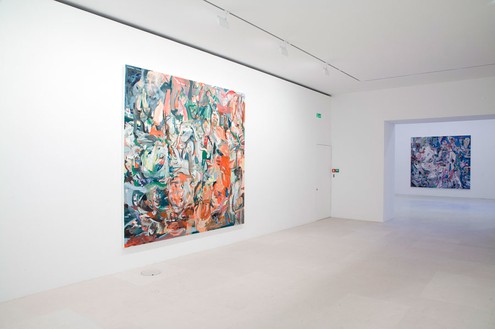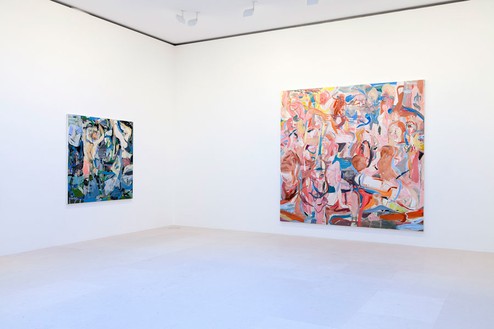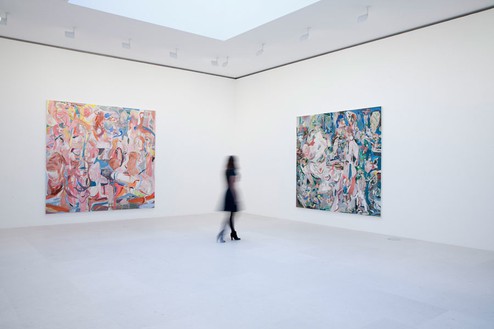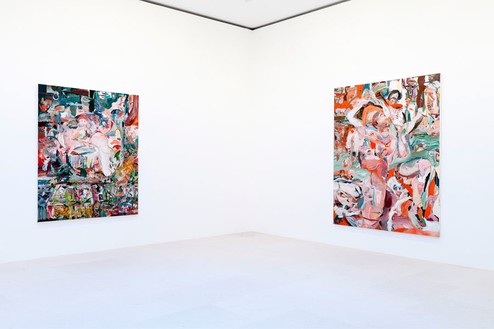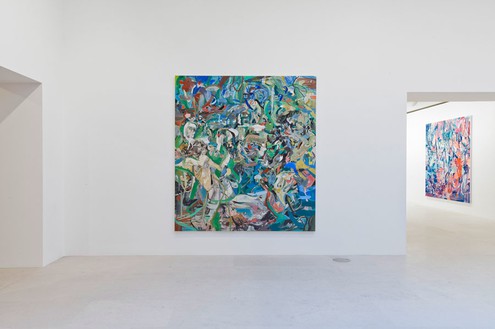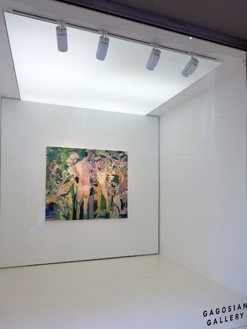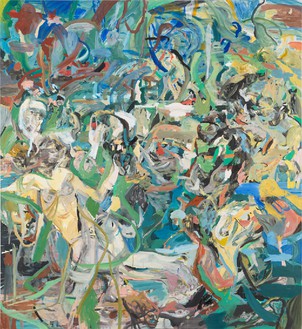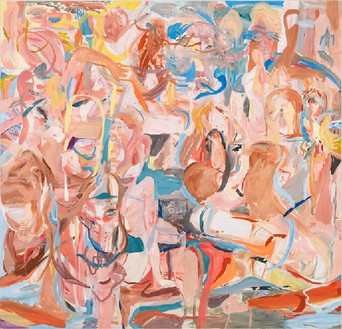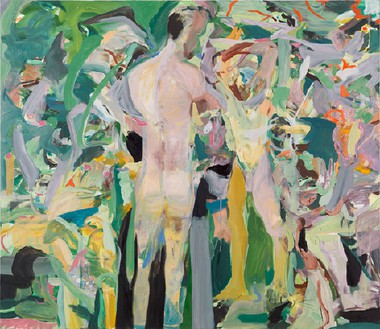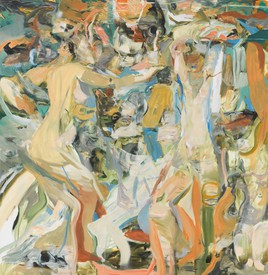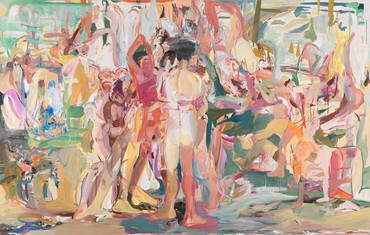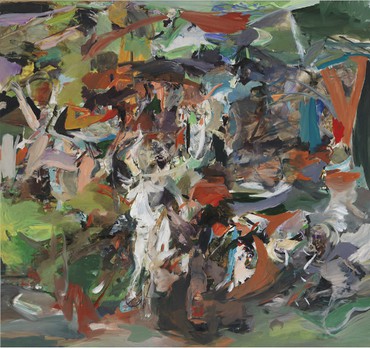About
Something that’s just glimpsed seems more real than something that’s fully described.
—Cecily Brown
Gagosian Paris is pleased to announce an exhibition of new paintings by Cecily Brown. This will be her first solo exhibition in Paris.
In recent times, Brown, a highly expressive contemporary painter in active dialogue with the history of painting, has been contending with the genres of figurative study and the nude ensemble. In her visible grapple with formal concerns, she conceives each canvas as a compositional flux, compressing subject and background, and incorporating a palette of bright contrasting hues. Stylistically diverse nudes—some loosely suggested, others clearly identifiable—make explicit her aim of conveying images in a barely elusive shorthand. This approach results in encounters with figures whose fleeting nature makes their presence all the more uncanny, implicating the viewer as voyeur in the visual game of hide-and-seek.
Hinting at figurative subjects from Impressionist paintings, and formulating cryptic titles from incidental sources including song lyrics and magazines, Brown oscillates between palettes of fleshy pinks and cool, verdant greens; isolated and grouped figures rendered as solid or translucent; and physiognomical features fully defined or represented by inconclusive smears. By freeing inspirations from their original contexts, she subverts the role of narrative in the construction of genre, and points to the slippage inherent in quoting from source. For example, in Hollyhocks that aim too high (2013), Brown recasts the subjects of Degas’s painting Young Spartans Exercising (c. 1860) into a lush green setting where limbs and trees intertwine; while in Combing the Hair (Côte d'Azur) (2013), the intimate boudoir scene of the nineteenth century genre painting is reimagined as a sinuous jumble of bodies that deliquesce into pulses of pinks, yellows, and blues worthy of a Côte d'Azur idyll.
« Ce qui est juste aperçu semble plus réel que ce qui est pleinement décrit »
—Cecily Brown
Gagosian Paris est heureuse d’annoncer une exposition de nouvelles peintures de Cecily Brown. C’est sa première exposition personnelle à Paris.
Dans ses derniers travaux, Brown, peintre contemporaine très expressive, en dialogue permanent avec l’histoire de la peinture, considère le genre de l’étude figurative et du nu dans son ensemble. Dans une confrontation évidente aux problématiques formelles, elle construit chaque toile comme une composition en mouvement, condensant le sujet et le contexte et y associant une palette de couleurs aux teintes brillantes et contrastées. Par des nus de styles différents—certains à peine suggérés, d’autres clairement identifiés—elle manifeste sa volonté de représenter des images par un raccourci évasif. Cette approche permet des rencontres avec des figures dont la nature fugitive rend la présence encore plus troublante, transformant le spectateur en voyeur dans un jeu visuel de cache-cache.
Faisant allusion à des sujets figuratifs de tableaux impressionnistes, Cecily Brown donne des titres énigmatiques provenant de sources accidentelles comme des paroles de chansons ou des magazines. L’artiste oscille entre des palettes de roses chair et de verts frais, des figures isolées ou en groupe, représentées de manière solide ou plus translucide et des caractéristiques physiques pleinement définies ou des traces non abouties.
En libérant ses sources d’inspiration de leur contexte d’origine, Brown détourne le rôle du récit dans la construction du genre et met en évidence le glissement inhérent à ces emprunts. Par exemple, dans Hollyhocks that aim too high (2013), Brown recrée le sujet du tableau de Degas Petites filles spartiates provoquant des garçons (c.1860) en un environnement de vert luxuriant où les membres du corps et les arbres s’entrecroisent alors que dans Combing the Hair (Côte d’Azur) (2013), la scène de genre intime du boudoir du dix-neuvième siècle est réimaginée comme un enchevêtrement sinueux de corps tombant en déliquescence dans des teintes de rose, jaune et bleu dignes d’une idylle sur la Côte d’Azur.
L’exposition s’accompagne d’un catalogue illustré contenant un essai de James Lawrence revu et augmenté pour cette publication (en français seulement).
Cecily Brown est née à Londres en 1969. Son travail est présent dans des collections publiques à travers le monde parmi lesquelles : Solomon R. Guggenheim Museum, New York ; Whitney Museum of American Art, New York ; Tate Gallery Londres. Parmi ses expositions personnelles on peut citer : « Directions : Cecily Brown », Hirshhorn Museum and Sculpture Garden, Washington D.C. (2002) ; MACRO, Rome (2003); Museo Nacional Centro de Arte Reina Sofía, Madrid (2004); Museum of Modern Art, Oxford (2005); Kunsthalle Mannheim (2005–06); Des Moines Art Center, Iowa (2006); Museum of Fine Arts, Boston (2006–07); Deichtorhallen, Hambourg (2009); “Based on a True Story” Kestner Gesellschaft, Hanovre (2010, exposition itinérante au GEM, Museum of Contemporary Art, La Haye); et Galleria Civica d’Arte Moderna e Contemporanea, Turin (exposition qui débutera le 16 octobre 2014).
Brown vit et travaille à New York.
Share
Artist
News

Art Fair
Art Basel Miami Beach Online
Gagosian Online
November 29–December 7, 2020
Presented in four forty-eight-hour cycles
gagosian.com
OVR: Miami Beach
VIP preview: December 2–4, 2020
Public viewing: December 4–6, 2020
artbasel.com
On the occasion of Art Basel Miami Beach 2020, which was canceled this year due to the COVID-19 pandemic, Gagosian is pleased to present works by modern and contemporary masters on two concurrent online platforms: Gagosian Online, which will feature four individually curated groupings of artworks in forty-eight-hour cycles, and OVR: Miami Beach.
Helen Frankenthaler, Distant Barrier, 1992 © 2020 Helen Frankenthaler Foundation, Inc./Artists Rights Society (ARS), New York

